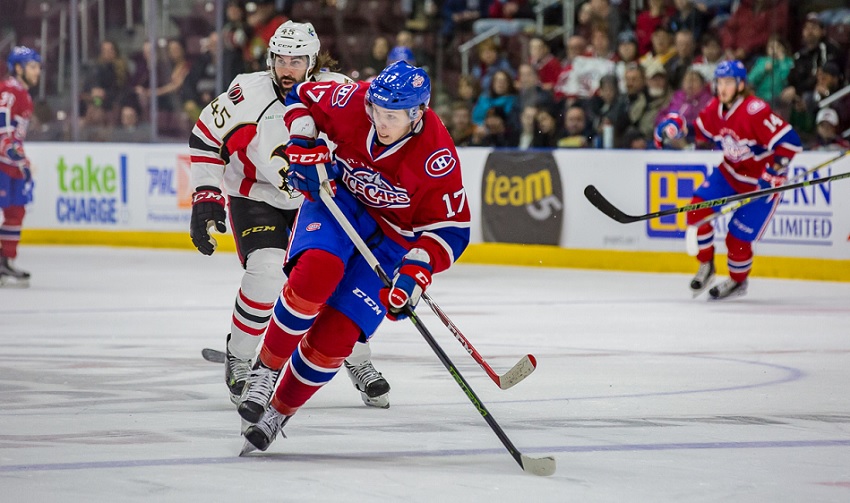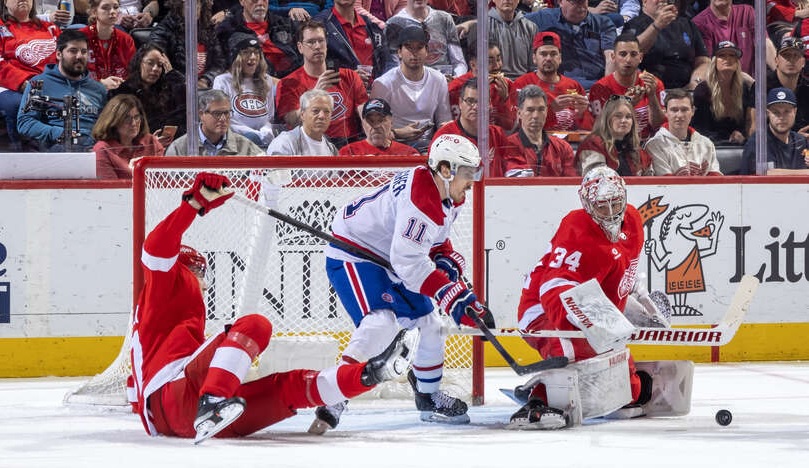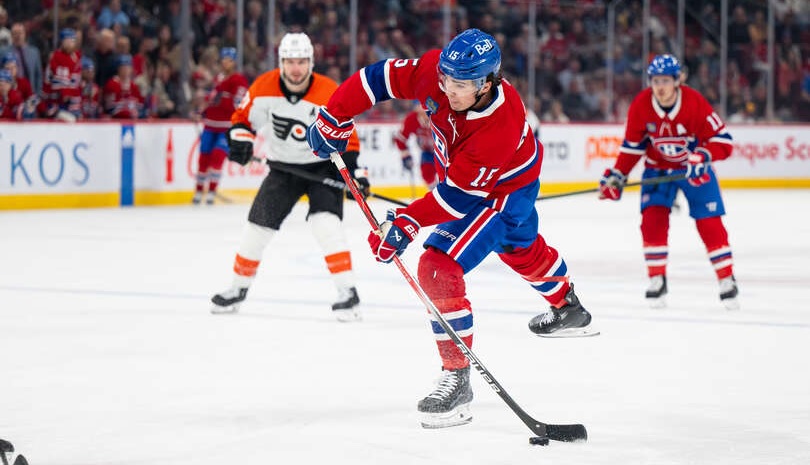HabsWorld.net --
The Habs had several junior-aged players under contract this past season. All but one of them failed to suit up with the Canadiens during the year and each one of them will see their contract slide back a year as a result. Here is a look at which prospects qualified and how their cap hit will be changed.
What is the ‘Slide Rule’?
If you’ve been a regular reader of this site, chances are you’ve seen me refer to ‘slide rule’ players. These are junior-aged prospects who were under contract for the previous season but did not suit up in ten or more games with the NHL team. As a result, their contract slides (gets extended by) an extra year with a corresponding change in their cap hit.
Who was eligible for a slide?
The Habs had a total of five junior-aged prospects under contract this past year and all of them will see their contract extended. Those players are Daniel Audette, Noah Juulsen, Brett Lernout, Michael McNiven, and Nikita Scherbak. Lernout was the only one to suit up with Montreal but played just one game which means he retained his eligibility.
How does the cap hit change?
In most instances, simply put, the cap hit is reduced by the value of the signing bonus paid in that season divided by the number of years remaining on the contract (which in this case is always three). The players’ NHL salary in the final year of the new deal is lowered by the signing bonus paid out in the season where the contract slid. There are some exceptions, however. If reducing the players’ NHL salary in that final season by the amount of the signing bonus takes the new salary below the league minimum, said players’ salary for that season will be the league minimum. In those cases, the basic calculation for the reduced cap hit (signing bonus divided by three) doesn’t apply. This comes into play for two of the prospects on this list.
New Cap Hits
Note: All NHL salary amounts include signing bonuses.
Daniel Audette: Audette was signed back in July in advance of his age-19 season. He spent the entire year in the QMJHL before joining St. John’s on a tryout to finish their season. Here is his new contract breakdown:
| Season | NHL Salary | Performance Bonuses | Signing Bonus | Cap Hit before Bonuses | Cap Hit with Bonuses |
| 2015-16 | Entry-level slide | $65,000 | $665,000 | $665,000 | |
| 2016-17 | $575,000 | $0 | $65,000 | $668,333 | $668,333 |
| 2017-18 | $650,000 | $0 | $65,000 | $668,333 | $668,333 |
| 2018-19 | $650,000 | $0 | $0 | $668,333 | $668,333 |
Audette’s salary in 2015-16 was $640,000. The league minimum in 2018-19, the season that’s added to his contract, is $650,000, a difference of $10,000. That amount, divided by three, is what is added to his cap hit.
Noah Juulsen: As is often the case with first rounders, Juulsen signed his ELC before last season started. He’s eligible for a contract slide both this year and next, assuming he doesn’t play in ten NHL games in 2016-17. Here is his new contract breakdown:
| Season | NHL Salary | Performance Bonuses | Signing Bonus | Cap Hit before Bonuses | Cap Hit with Bonuses |
| 2015-16 | Entry-level slide | $92,500 | $925,000 | $1,125,000 | |
| 2016-17 | $925,000 | $0 | $92,500 | $894,167 | $1,094,167 |
| 2017-18 | $925,000 | $425,000 | $92,500 | $894,167 | $1,094,167 |
| 2018-19 | $832,500 | $175,000 | $0 | $894,167 | $1,094,167 |
Juulsen’s salary in 2015-16 was $925,000. That amount is subtracted by the signing bonus to come up with the $832,500 salary for 2018-19. The savings are the signing bonus divided by three, or $30,833.
Brett Lernout: Lernout is eligible to slide despite playing the entire season in the minors (plus one game with Montreal) as the rule is ten NHL games played to trigger the first year of an entry-level deal, not ten pro games. Here is his new contract breakdown:
| Season | NHL Salary | Performance Bonuses | Signing Bonus | Cap Hit before Bonuses | Cap Hit with Bonuses |
| 2014-15 | Entry-level slide | $85,000 | $685,000 | $850,000 | |
| 2015-16 | Entry-level slide | $85,000 | $656,667 | $821,667 | |
| 2016-17 | $685,000 | $215,000 | $85,000 | $653,333 | $818,333 |
| 2017-18 | $650,000 | $165,000 | $0 | $653,333 | $818,333 |
| 2018-19 | $650,000 | $115,000 | $0 | $653,333 | $818,333 |
Lernout’s salary in 2015-16 was $635,000, $60,000 above the minimum. The league minimum in 2018-19 is $650,000, a difference of $15,000. However, his signing bonus in 2015-16 was $85,000 so a savings is still created [$85,000 – ($60,000 + $15,000)]. That amount ($10,000), divided by three, is what is subtracted from his cap hit.
Michael McNiven: McNiven signed in September after going undrafted. As an 18 year old, he’s also eligible to slide next season as well. Here is his new contract breakdown:
| Season | NHL Salary | Performance Bonuses | Signing Bonus | Cap Hit before Bonuses | Cap Hit with Bonuses |
| 2015-16 | Entry-level slide | $70,000 | $646,667 | $683,333 | |
| 2016-17 | $645,000 | $55,000 | $70,000 | $648,333 | $685,000 |
| 2017-18 | $650,000 | $55,000 | $0 | $648,333 | $685,000 |
| 2018-19 | $650,000 | $0 | $0 | $648,333 | $685,000 |
McNiven’s NHL salary for 2015-16 was $645,000 which falls $5,000 shy of the league minimum for the added year, 2018-19. Accordingly, that amount divided by three is added to the cap hit.
Nikita Scherbak: Like Lernout, Scherbak is able to slide for a second (and final) time despite playing full-time in the AHL last season. Here is his new contract breakdown:
| Season | NHL Salary | Performance Bonuses | Signing Bonus | Cap Hit before Bonuses | Cap Hit with Bonuses |
| 2014-15 | Entry-level slide | $92,500 | $925,000 | $1,125,000 | |
| 2015-16 | Entry-level slide | $92,500 | $894,167 | $1,094,167 | |
| 2016-17 | $925,000 | $0 | $92,500 | $863,333 | $1,063,333 |
| 2017-18 | $832,500 | $425,000 | $0 | $863,333 | $1,063,333 |
| 2018-19 | $832,500 | $175,000 | $0 | $863,333 | $1,063,333 |
Scherbak’s salary in 2015-16 was $925,000. That amount is subtracted by the signing bonus to come up with the $832,500 salary for 2018-19. The savings are the signing bonus divided by three, or $30,833.


